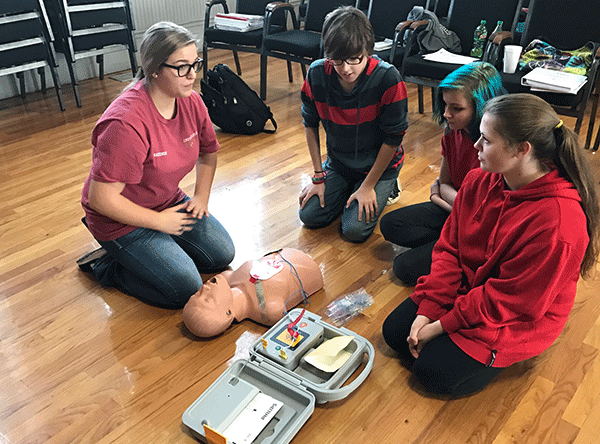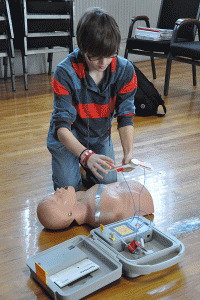CPR CERTIFICATION: HOSA students become certified CPR instructors
Published 11:33 am Thursday, December 22, 2016

Luverne High School junior and Health Occupations Students of America (HOSA) member Mackenzie Carlos (left) instructs her fellow students in the proper way to attach and use an Automated External Defibrillator (AED).
Recently, the Crenshaw County Health Occupations Students of America (HOSA) group held a Cardiopulmonary Resuscitation (CPR) certification course for interested students.
“A goal of Career Technical Education (CTE) is to provide our students with credentialing related to the field they desire to pursue after high school,” said Becky Cornelius, health science teacher for Crenshaw County Schools.
“We also refer to them as Career Readiness Indicators (CRIs). The Basic Life Support (BLS) Instructor is a CRI under the Health Science career cluster.”
On Nov. 17, HOSA had 12 junior health science students sit for the eight-hour instructor course provided by a credentialing company called Trio Safety out of the Birmingham area.
The students had to pass an exam at the end to prove they had the knowledge necessary to become an instructor. To obtain the full credential, they were required to teach a CPR course and be monitored during their instruction. This course took place last Friday from 8-11 a.m. in the Luverne High School auditorium.
“Two of the 12 students had already taught their monitored courses, but we still lacked courses for the other 10. So another LHS faculty member, Beverly Sport, who also serves as the students’ anatomy teacher, suggested teaching a course the last day before we got out for Christmas,” Cornelius said.

Luverne High School student Elijah Brooks practices his skills with the Automated External Defibrillator (AED).
“She helped with the recruiting for the class as we all reached out through Facebook and email to advertise the course, too. We ended up with 12 participants in the Heartsaver CPR course, one of whom was a former HOSA student, and the others were students at LHS desiring to obtain the certification.”
During the course, students spent the first half of the class watching preparatory videos, which instructed them on the signs of someone in need of CPR, the steps to take to ensure the safety of the injured individual and those around, how to initiate and maintain CPR until medical professionals arrive on the scene and how to use and operate an Automated External Defibrillator (AED).
“Us as HOSA students are doing this so we can get our final credentials to finalize being able to become CPR instructors, and we instructed the people who came here in Heartsaver CPR,” said Nick Baugh, junior HOSA member from LHS.
“It’s good to learn CPR at any age because there’s no telling when someone is going to collapse and need CPR. If there’s no one around who knows it, no one can help. It’s even better when you’re younger because you have your entire life ahead of you to potentially help someone.”
Baugh, along with Mackenzie Carlos and other HOSA student leaders, instructed and later performed check offs for students who felt ready to perform CPR on mannequins.
“We’re trying to raise more awareness and get people ready for getting out there to potentially have someone else’s life in their hands,” Carlos said.
According to Carlos, there are two levels of CPR certification, Advanced Cardio Life Support (ALS) and Basic Life Support (BLS); Carlos is currently BLS certified and instructor certified through BLS.
Carlos and Baugh both have been members of HOSA since the ninth grade, and both are now interested in pursuing careers in the medical field.
“Seeing them progress from what they didn’t know to actually being able to show me that they can go out there and apply what they’ve learned in here is my favorite part,” Carlos said.
“I would really love to see them save a life. Being able to be CPR certified means that you are helping other people. If you are certified, that’s someone’s family member that you are helping save if they went into cardiac arrest. You’re able to say, I know what I’m doing and I helped them.”
After successfully completing this course, students were then certified to be on the scene in the case of someone collapsing, able to apply proper CPR techniques and are also able to operate an AED.
“I am super proud that my health science students can show such responsibility, maturity and knowledge to teach these courses to help more people save lives,” Cornelius said.
“Through CTE, we truly are preparing our students for college and careers with this type rigorous addition to our Crenshaw County health science program.”





